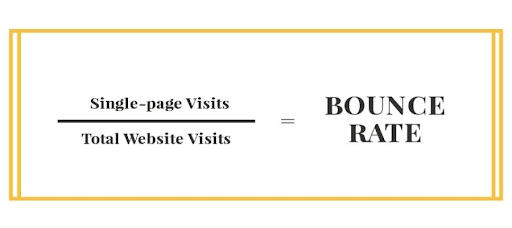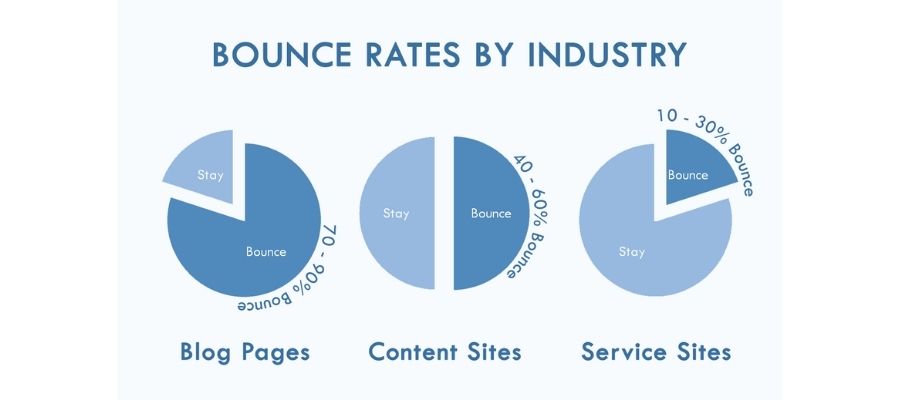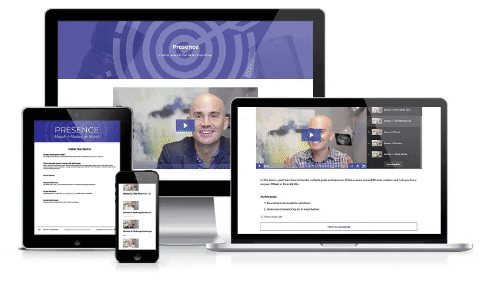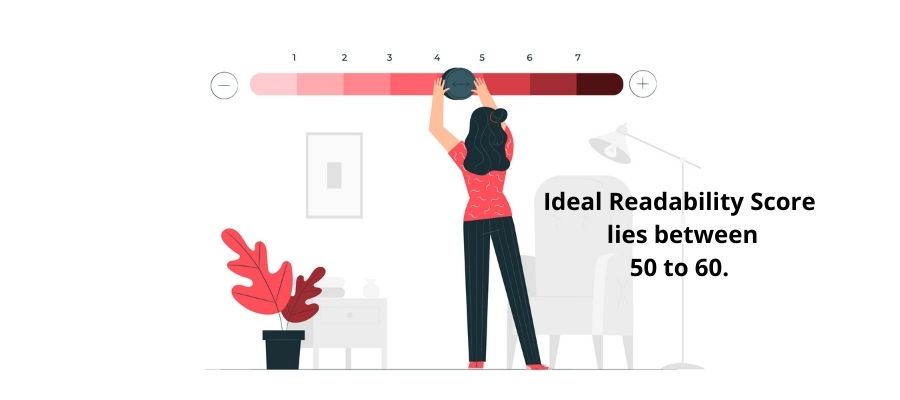Rein-in the Bounce Rate: 10 Top Tips for UX
It’s a universal truth that users want to get in and out of your site as quickly as possible. What is the bounce rate, you ask? It measures how many people leave your website after visiting just for a very minuscule time.
Quick Links
The bounce rate can be pretty high for websites with a lot of content, and it’s not uncommon to find sites with 60% or more of their visitors bouncing off the site immediately after arriving. But don’t worry- there are some easy ways to reduce this number!
Here’s a glance at the vital tips for controlling the bounce rate of your website:
- Learn to differentiate between ideal values and achievable values
- Analyze when and where the users are bouncing back
- If you don’t look good (on different screen sizes), you won’t sell well
- Focus on providing intuitive experience to the web visitors
- Perform intensive A/B testing
- Leverage visuals
- Prominent call to action to enhance your conversion rates
- Use fresh content
- Avoid ranking on negative/irrelevant keywords
- Improve the readability score
Before we divulge into details, let us discuss a few common factors about the Bounce rate.
What is the Bounce Rate?

The bounce rate is the percentage of visits to a site where the visitor leaves immediately or in a very short time. The higher your website’s bounce rate, the more you should consider how optimized it is for user experience and engagement with all visitors—not just those returning or having bookmarked your site.
It’s essential to measure how many people are bouncing off your site so you can find ways to reduce this number.
There is a lot of talk in the digital marketing world about the bounce rate metric, and there’s no question that it matters because Google has also noticed it. Some say improving your website’s experience will make users less likely to bounce off your site, but that’s not always the case.
There have been reports of websites with high user experience metrics having a higher bounce rate than sites without them. Often, UX is subjective and different users may find it more or less compelling for one reason or another.
The takeaway here is that many factors are involved in determining whether a visit bounces off your site, and how much bounce rate matters depends on the type of business you’re running.
As a website owner, you want people who land on your site to stay there & engage with what’s offered. When visitors bounce off the page after landing, it means that your content isn’t resonating or matching their expectations of what they were looking for.
The best way to reduce bounce rates is by ensuring that what users see when they land on your website matches their expectations, which means having great content in every possible viewport size and screen resolution.
How to Calculate Bounce Rate?

Source: Insight Whale
If your website has many pages, you may want to measure how many people view more than one page on average before they leave.
The easiest way to calculate bounce rate is by dividing the number of visits that only viewed the page for a very short time before leaving by the total number of visits in a given period (typically monthly). If you’re logging data in Google Analytics, you can find the bounce rate under Audience > Overview.
You should also know that the number-of-pages metric is a popular one for measuring engagement on your site and will give you an idea of how many people are sticking around beyond just viewing one page before leaving.
Bounce rates depend primarily on what you’re trying to accomplish with your website and its value for potential visitors.
Why is it Necessary to have a Balanced Bounce Rate?

Source: Bounce Rate Benchmarks
A high bounce rate could hurt your website’s search engine rankings, especially if the site has many pages. Google does not rank well-placed content on low traffic or poorly performing sites in its organic results for competitive keywords that are valuable to your business.
Users can also perceive you as spam because they believe you’re trying to force them into buying something.
A low bounce rate also indicates a site with higher rankings in search engine results pages because Google wants its users to find what they are looking for as quickly and efficiently as possible.
However, having a Bounce rate that’s too low and lies under 20% indicates that your website is inaccessible on local keywords. Note: You need to check your overall number of visitors in such a scenario to find out whether you have a fantastic website or the website needs the help of SEO.
Getting back to Bounce rates: A high number of bounces is usually caused by several factors, such as a lack of relevance to the search query, poor content quality, a poorly optimized site design, and navigation.
You can reduce bounce rates by focusing on improving your website’s conversion rate while maintaining an excellent user experience. However, it is essential to determine the actual reason behind the high bounce rate of the website.
Significant Factors Leading to High Bounce Rates
Wrong Search Engine Optimization – You need to remember that not everyone finds your site the same way. You might have a great SEO strategy, but someone looking for something specific may find their way to your site through different means. It can lead people straight back out if they don’t see what they wanted on the first page of search results.
Poor Content Quality – If your content is not up to the mark, visitors will leave quickly without reading anything. They might get the gist of what they were looking for and move on, or they may just find another site that looks more trustworthy because it has higher quality content. Either way, they are gone!
Unfriendly Navigation Design – No one wants to work hard for what they want. It is especially true if someone is looking for something specific, as it’s much easier to click the back button than spend minutes trying different filters or sorting options just to find what you need! If visitors have a difficult time navigating your site, they are going to leave and move on.
Poor Site Loading Speed – As a general rule, people are impatient. They don’t want to wait for your site to load, and they will leave if it’s not quick enough! It can be due to server issues or simply that you have too much content on the page getting loaded at once.
Non-Intuitive Page Design – Most people think of elegance, but it’s not just about aesthetics. It also includes how easy your website is to navigate and read content on!
Mobile Compatibility Issues – Whether you are in a mobile or desktop browser, people want what they want NOW. If your site isn’t compatible with their device or fails to look great when viewed from one, they will leave and never come back.
Security Issues – It’s natural to feel a little bit anxious when you are on the internet, but that should not be your only concern! Visitors want to ensure their information is safe before entering any passwords or other sensitive data into your site. If there aren’t security features built-in, visitors will be looking for another site in moments.
Poor User Experience – Just like you want a positive experience when you visit someone’s home, visitors to your site should have an enjoyable time! If they find your content difficult to read or navigate through, they’re leaving. You don’t need them!
Long Feedback Forms – If you have a contact form or feedback link on your site, make sure it works! No one wants to spend time filling out a survey for something and not getting anything in return. It is also true of any other kind of support offered on the site.
The Following 10 Tips will Help you Lower your Bounce Rate by Making Sure your User Experience is Top-notch
1. Learn to differentiate between ideal values and achievable values
Good numbers are low numbers (percentage), like when many people stay on your site and see a lot of pages. Bad numbers are high numbers(percentage), like when someone sees only one page before leaving the site. Here are the tips:
- Bounce rate is above 80%: The site gives a poor user experience, or the website is overcrowded with content that does not match what was searched for.
- Bounce rate is above 30% and below 50%: The site provides an excellent user experience, or the website has very few pages, and those are related to what was searched for on Google. If your site’s bounce rate is in this range, it means that you’re doing a great job with SEO, and you don’t need to worry about bounce rates anymore.
- Bounce rate is below 20%: Your website is simply unavailable to the users on the right keywords. You need the services of experts to optimize the website over the more compatible keywords and enhance its visibility over the search engine.
2. Analyze when and where the users are bouncing back
You need to find out when the user is leaving. If it’s right after landing your page, then it’s the issue with the intent. Your websites are ranking on negative keywords that need to be addressed.
For example, a user looking forward to buying used smartphones will contribute to the website’s bounce rate-selling new smartphones.
If a user is bouncing after considerable time, you need to try alternative options for content via A/B testing.
3. If you don’t look good (on different screen sizes), you won’t sell well

Responsive design is a way to ensure that the layout of your website can adapt to various screen sizes, input methods, and device capabilities. The obvious benefit for businesses with responsive sites is lower bounce rates due to more streamlined navigation or visuals.
As per Failory, 57% of all devices accessing the web are from mobile web browsers using responsive designs. For driving traffic & increasing conversions, your website must be fully responsive.
With the advent of smartphones & mobile devices with varying screen sizes, you will lose a significant number of customers if not all visitors have an optimal viewing experience on your site.
4. Focus on providing intuitive experience to the web visitors
Reducing bounce rates takes more than a good design. It is the overall sum of visual elements, information, and interaction you meet expectations and positively exceed them. Stay mindful of your buyer persona at all times.
Think about what they are looking for on your site when they enter it. Take advantage of features to lead them where you want them to go. Focus on the following:
-Visual content is intimate with your users, as well – it should be engaging and easy to access for people to stay on your website longer;
-Your design layout needs to guide visitors through a logical flow of information so that they know where they are on your site;
-Users are more inclined to stay on a website when they know where the information they need is located. Provide them with clear navigation options.
5. Perform intensive A/B testing
To improve your conversion rate, make sure you test different versions of the same page. If your site has a high bounce rate, run an experiment to see which design improved traffic and retention rates the most.
A/B testing is the ultimate solution that lets you do all of it with the option of tracking results in real-time.
6. Leverage Visuals
Visuals have a tremendous power to communicate with the user. Make use of images, graphics, and videos because it will keep them on your site for longer and increase their viewing time by up to 200%, as per Failory.
Images are not only of any importance to your visitors. They also help with SEO and give you an edge over competitors because they increase the page views by 57%, as per Statista.
Include high-quality visuals relevant to your content topic, but don’t overload visitors with too many pictures as they get bored or distracted.
7. Prominent Call to Action to enhance your conversion rates

Create your call to action with a clear and concise message. Users should not have to spend time finding the call to action button. It leads to severe frustration among web visitors.
If you are using an online shopping cart, it is appropriate to direct visitors back into the product page instead of going through other pages that may distract them from completing a purchase.
8. Use Fresh Content
Generate new content that is fresh & original material. Create blogs and articles relevant to your business niche; by doing this, you will attract more visitors on a long-term basis.
Creating fresh content is vital to reduce a site’s bounce rate and build trust with readers. The more frequently you update the site, the more trust people will have in what you publish and your message’s success.
Readers can see through deceptive or manipulative tactics so make sure that your every action step and word is transparent, honest, and trustworthy.
9. Avoid ranking on negative/irrelevant keywords
Although I have given a hint of it in my earlier example, where people trying to buy used smartphones land on the page of new smartphone selling websites, I feel it’s a point worth discussing. Keywords are essential to attract customers, but your bounce rate will be higher if you rank high for negative terms or irrelevant search queries.
Ranking on irrelevant keywords never gains you with the right set of clients and potent customers. No sooner the user visits your page than they click on the back icon. Similar actions from a large user base lead to an undesired hike in the website’s bounce rate.
You need to take the time and effort to order a list of relevant keywords before doing anything else. Avoid using too many because it will result in lower rankings on Google’s SERPs as well.
10. Improve the readability score

Enhance the readability score of your content by using the following:
- headings, subheadings, and paragraphs;
- bulleted lists or numbered lists to break up content;
- short sentences with a maximum of 25 words.
Providing users with vague and ambiguous content leads to confusion among web visitors. While being unique & innovative is appreciated by all, the users must learn about the essential products and services of the website within seconds of landing on the page.
Note: The readability score of this article stands at 64.
Wrapping Up
That was all about the top tips and advice necessary for keeping your bounce rate at bay. Implementing them over your website will help you track and control the bounce rate of your firm.
You can connect with a web designing company to rein-in your bounce rate at an affordable budget.
I hope the blog answers all your queries related to bounce rate & how you can improve it through UX.
Author Bio
Varun Bhagat is a technical consultant & blogger working for PixelCrayons, which is a leading web design and development company. He possesses in-depth knowledge of all the tech-related stuff and likes to share his knowledge with like-minded people.
Why WooCommerce is the Best Choice for Your Online Store?
WooCommerce stands out as a top option for anyone looking to build an online store. This platform…
0 Comments8 Minutes
How to Use AI-Powered SEO Tools for WordPress eCommerce
SEO is a critical factor in the success of any e-commerce WordPress store. As competition…
0 Comments11 Minutes
Why Short-Form Videos Are the Future of Content Marketing
Your Instagram customers spend over 50% of their time watching short-form videos and reels. Rather…
0 Comments12 Minutes
The Role of Digital Marketing in Business Growth
Online marketing touches every aspect of a business, whether it is initiating the idea or for an…
0 Comments3 Minutes
AI Meets Authenticity: Balancing Automation and Human Touch in Content Marketing
Is your brand starting to sound like a robot? In a world where algorithms write faster than any…
0 Comments8 Minutes
Essential Tools for Enhancing Web Design and UX Hosting
Have you ever visited a website that felt slow, clunky, or confusing? A website that is poorly…
0 Comments11 Minutes
How a Mini Cart Transformed My Store’s Shopping Experience
Okay, real talk—running an online store is hard. You think you’ve got everything figured out, you…
0 Comments9 Minutes
Balancing Your Security Initiatives With Industry Compliance Requirements
Managing a business today comes with a number of daily battles that need to be fought. Resources…
0 Comments11 Minutes
2 Comments
Comments are closed.









Your bounce rate is an important metric to track. If a lot of people are leaving your site after they find it, chances are pretty good that it means that their expectations aren’t being met.
Bounce Rates play a huge role in improving your rankings on search engines. Your post provided me with so much valuable information on how to reduce it, like having a responsive design, using visuals, and so much more. I have noted them and will surely implement them on my blog.